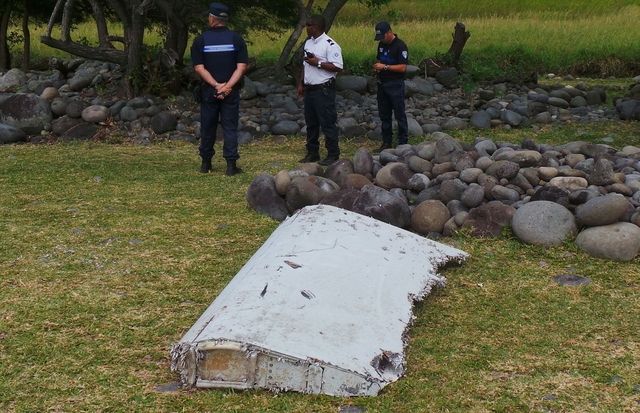A piece of a wing that washed up on an Indian Ocean island beach last week was part of the wreckage of Malaysian Airlines flight MH370, Malaysia said on Thursday, confirming the discovery of the first trace of the plane since it vanished last year.
"Today, 515 days since the plane disappeared, it is with a heavy heart that I must tell you that an international team of experts have conclusively confirmed that the aircraft debris found on Reunion Island is indeed from MH370," Prime Minister Najib Razak said in an early morning televised address.
"I would like to assure all those affected by this tragedy that the government of Malaysia is committed to do everything within our means to find out the truth of what happened," Najib said.
The announcement, by providing the first direct evidence that the plane crashed in the ocean, closes a chapter in one of the biggest mysteries in aviation history but still gives families of the 239 victims little clue as to why.
"It's not the end," said Jacquita Gonzales, who lost her husband Patrick Gomes, a flight attendant on board the aircraft.
"Although they found something, you know, it's not the end. They still need to find the whole plane and our spouses as well. We still want them back," she said.
The airline described the discovery as "a major breakthrough for us in resolving the disappearance of MH370.
"We expect and hope that there would be more objects to be found which would be able to help resolve this mystery," it said in a statement issued as soon as Najib had spoken.
The fragment of wing known as a flaperon was flown to mainland France after being found last week covered in barnacles on a beach on France's Indian Ocean island of Reunion.
Despite the Malaysian confirmation it was part of MH370, prosecutors in France stopped short of declaring they were certain, saying only that there was a "very strong presumption" that it was the case.
Paris Prosecutor Serge Mackowiak said this was based on technical data supplied by both the manufacturer and airline but gave no indication that experts had discovered a serial number or unique markings that would put the link beyond doubt.
Boeing representatives confirmed that the flaperon came from a 777 jet "due to its technical characteristics, mentioning the colour, the structure of the joints," he said.
Secondly, Malaysia Airlines was able to provide documentation of the actual aircraft used on flight MH370.
"On this basis, it was possible for a connection to be made between the object examined by the experts and the flaperon of the Boeing 777 of MH370," Mackowiak told reporters in Paris.
He said more analysis would be carried out on Thursday, but he could not say when further results would be announced.
A fragment of luggage also found in Reunion would be examined by French police as soon as possible, he added.
"Yet to begin"
Investigators looking at the wing flap are likely to start by putting thin slices of metal under a high-powered microscope, to see subtle clues in the metal's crystal structure about how it deformed on impact, said Hans Weber, president of TECOP International, Inc., an aerospace technology consulting firm based in San Diego, California.
Later, investigators would probably clean the piece and "do a full physical examination, using ultrasonic analysis before they open it up to see if there's any internal damage," Weber said. "That might take quite awhile. A month or months."
John Goglia, a former board member of the U.S. National Transportation Safety Board, told Reuters: "The real work is yet to begin".
"They will identify everything they can from the metal: damage, barnacles, witness marks on the metal. They're going to look at the brackets (that held the flaperon in place) to see how they broke. From that they can tell the direction and attitude of the airplane when it hit. There's a lot to be told from the metal."
However, experts said the cause of the disaster may remain beyond the reach of investigators until other debris or data and cockpit voice recorders are recovered.
"A wing's moving surfaces give you far fewer clues than bigger structures like the rudder, for example. As a single piece of evidence, it is likely to reveal quite little other than it comes from MH370," said a former investigator who has participated in several international probes of crashes at sea.
The examination of the part is being carried out under the direction of a judge at an aeronautical test facility run by the French military at Balma, a suburb of the southwestern city of Toulouse, and witnessed by Malaysian and other officials.
Officials from the United States, Australia, China, Britain and Singapore as well as manufacturer Boeing were also on hand. Boeing said it was providing technical expertise.
Flight MH370 disappeared on March 8 last year while en route from Kuala Lumpur to Beijing. It is believed to have crashed in the southern Indian Ocean, about 3,700 km (2,300 miles) from Reunion.
The Boeing 777 was minutes into its scheduled flight when it disappeared from civil radar. Investigators believe that someone may have deliberately switched off the aircraft's transponder, diverted it thousands of miles off course, and deliberately crashed into the ocean off Australia.
A $90 million hunt along a rugged 60,000 sq km patch of sea floor 1,600 km (1,000 miles) west of the Australian city of Perth has yielded nothing.
The search has been extended to another 60,000 sq km (23,000 sq miles) and Malaysian and Australian authorities say this will cover 95 percent of MH370's flight path.


















































